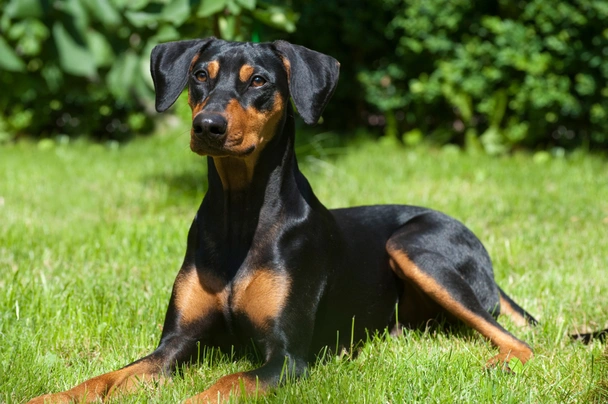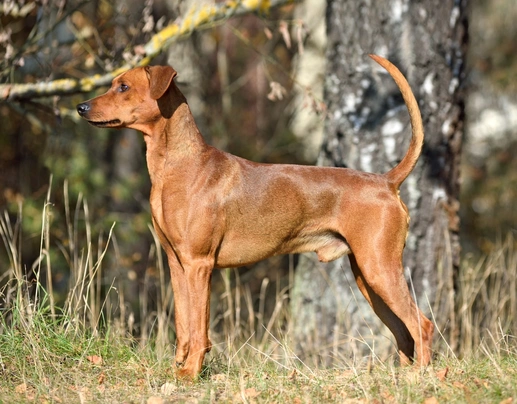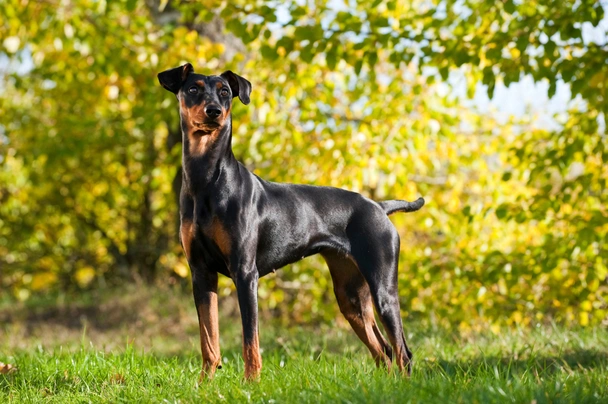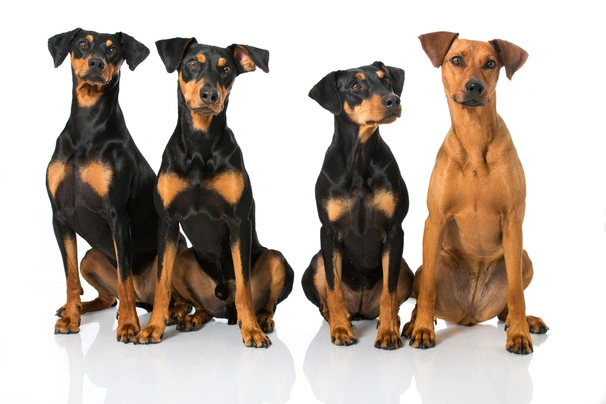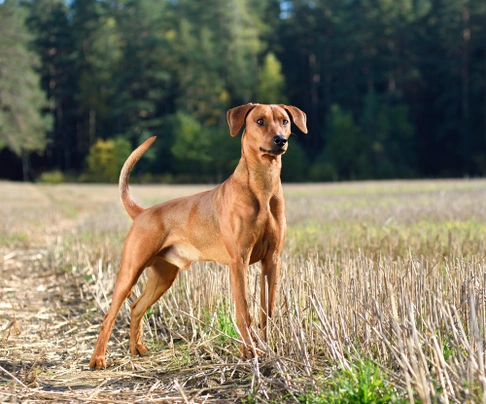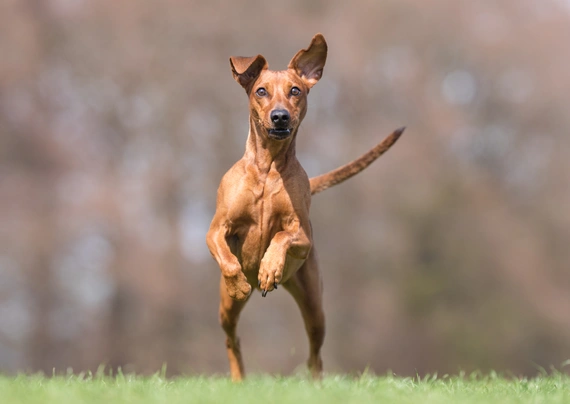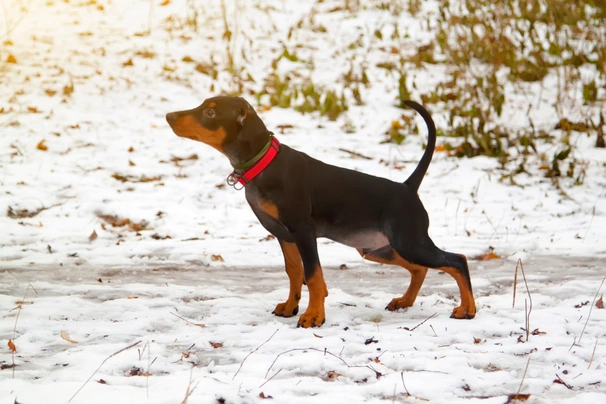German Pinscher
Pros
Cons
Introduction of the German Pinscher
The Pinscher is a handsome medium sized dog that’s very similar looking to the Dobermann. The breed is native to Germany where they were originally bred to hunt vermin and where they are still very highly prized. However these elegant dogs are quite rarely seen here in the UK and only very few well-bred puppies are bred and registered with The Kennel Club every year. As such anyone wishing to share their home with a Pinscher would need to register their interest with breeders and agree to being put on a waiting list.
The breed is also known as the “German Pinscher” and thanks to their loyal and kind natures they are finding a bigger fanbase outside of Germany more especially in other European countries. Today the Pinscher has earned the reputation of being a lovely family pet although they are better suited to households where the children are slightly older.
History of the German Pinscher
Pinschers are a relatively new breed having first been developed in Germany during the 19th Century. They were specifically bred to be “stable dogs” and their role was to control vermin as well as protect and guard their environments tasks they were especially good at. A man called Josef Bertha founded the “Pinscher Klub” in 1895 but a few years earlier breeders had ensured that the Pinscher’s appearance had been clearly defined through careful and selective breeding. A breed standard had been established a few years earlier in 1884 which was then amended when the “Klub” was founded and when the breed was officially recognised.
To begin with a German Pinscher came in a variety of coat colours bearing in mind that the Standard Schnauzer and the Pinscher were the descendants of various other breeds which includes the Rat Pinscher the Great Ratter and the Rat Catcher all of which are now extinct. The German Pinscher also has the illustrious title of being one of the foundation breeds of the Miniature Pinscher and the Dobermann. With this said the breed was never as popular as the Schnauzer and at the beginning of the 19th Century their numbers fell into decline more especially at the outset of the Second World War. The last litter was whelped and registered in the stud book in 1949. It was not until around 10 years later that any litters were produced which saw the breed almost vanish altogether.
A man called Werner Jung who was closely associated with the German Pinscher-Schnauzer Klub made it his mission to save the breed and set about establishing a breeding programme. Fortunately through careful and selective breeding be produced German Pinschers which went under his “kennel name” of v/d Birkenheide.
He took his dogs to All Winners Shows that were held in Germany at the time where people noticed them as being larger Pinschers that were known as the “Deutscher Pinscher” which we now know as the German Pinscher. The dogs were such a success that interested parties travelled to the breeder’s kennels. One of the females in a litter was called “Blista” and she was imported to the UK where she had to spend 6 months in quarantine. It was the beginning of a breeding programme that was to be established in the UK.
A breed club was founded in England in 1981 and the Pinscher was officially recognised as a breed by the Kennel Club several years later in 1988 although for the first years of their registration the breed was only allowed to be exhibited at Dog Shows around the country in “Not Separately Classified” classes. Over time this changed and the breed could be exhibited at Championship shows and more Pinschers were imported into the country even though they had to spend so much time in quarantine.
Breed numbers remained quite low even in the early twentieth century but thanks to the efforts and dedication of breed enthusiasts and the fact that dogs no longer needed to be put into quarantine when they were imported from Europe more dogs were introduced into the country. As a result more interest in the German Pinscher was born with people throughout the UK showing an interest in the breed like never before.
As previously mentioned today the Pinscher remains a popular choice both as a working dog and companion in their native Germany. These handsome dogs are recognised as a breed by The Kennel Club but very few puppies are registered every year which in short means they have not gained the popularity that these charming and loyal dogs deserve here in the UK. Anyone wishing to share their home with a Pinscher would need to register their interest with breeders and agree to being put on a waiting list.
Interesting facts about the breed
- Is the Pinscher a vulnerable breed? No the breed is fast finding a fanbase in the UK although anyone wanting to share a home with a Pinscher would need to register their interest with breeders bearing in mind that well-bred Kennel Club registered puppies can often command a lot of money
- The first ever Pinschers to be exhibited at Crufts were a male blue and tan dog called Legget’s Tubize Buccaneer and a female black and tan called Smith’s Tubize Hally
- Traditionally a Pinscher’s tail was always docked but since the law banning the procedure came into effect in 2007 tail docking is now illegal with the exception being for some working breeds and if a dog suffers from some sort of health issue that requires their tails to be docked. The procedure must be agreed and authorised before being performed by a qualified vet
Appearance of the German Pinscher
Height at the withers: Males 43 - 51 cm Females 43 - 48 cm
Average weight: Males 11 - 20 kg Females 11 - 20 kg
The Pinscher or German Pinscher as they are often called is a medium sized dog that boasts a smooth and shiny close-lying coat. They are handsome elegant yet sturdy looking dogs that are smaller than the Dobermann but larger than their Miniature Pinscher cousins. Their heads are quite blunt and they don't have a very pronounced occiput but they do have a slight yet distinct stop. They have well developed cheek muscles and nice deep muzzles. Noses are black and large although red coated dogs can have lighter coloured noses.
They have dark medium sized oval shaped eyes that are set forward on a dog's head and which boast tight rims. Their ears are set high and V-shaped falling close to the head. The Pinscher has a strong jaw with a perfect scissor bite where their upper teeth neatly overlap their lower ones. They have strong elegant necks with a well arched nape.
Shoulders are well laid back and muscular. Their front legs are straight powerful showing a good amount of bone. Chests are moderately wide with dogs having flat ribs and their briskets fall to the elbow. A Pinscher's body is compact and well-muscled with dogs having short slightly sloping backs and a nicely rounded croup. Their back legs are strong and well-muscled with well-developed upper thighs. Feet are nicely arched compact and very cat-like in appearance with firm pads and strong dark nails. Their tails are set high with dogs carrying them high in an upward sweep which adds to a dog's overall balanced look.
When it comes to their coat the Pinscher boasts having a short smooth close-lying dense coat that's naturally very glossy. The accepted breed colours for Kennel Club registration are as follows:
- Black and tan
- Blue and tan
- Fawn
- Red
It is worth noting that the accepted colours for Kennel Club registration may differ from those as set out by the Breed Standard.
Gait/movement
When a Pinscher moves they do so with a well-balanced vigorous free action showing a good amount of reach in front and lots of drive from behind. Dogs hold their toplines firm and strong when they are on the move never showing any hint of hackney action.
Faults
The Kennel Club frowns on any exaggerations or departures from the breed standard and would judge the faults on how much they affect a dog's overall health and wellbeing as well as their ability to perform.
Males should have both testicles fully descended into their scrotums and it is worth noting that a dog can be a little lighter or heavier as well as slightly taller or shorter than set out in the Kennel Club breed standard which is only given as a guideline.
Temperament of the German Pinscher
The Pinscher is known to be a calm and even-tempered character in a home environment more especially when they are well-bred. They are extremely intelligent and always on the alert because they like to know what is going on around them. They are naturally very protective of their owners and their properties which in short means they make excellent watchdogs although rarely would a Pinscher show any sort of aggressive behaviour preferring to stand their ground in front of people they don’t already know.
They boast having a tremendous amount of energy which means they must be given the right amount of daily exercise to be truly happy well-rounded and obedient dogs bearing in mind that they can be independent-thinkers when the mood takes them. They also need a ton of mental stimulation so that boredom does not set in which could result in a dog developing some unwanted and destructive behaviours around the home which is their way of relieving any stress they may be feeling.
The Pinscher is not a good choice for first time owners because they need to be with people who have the time needed to dedicate to a highly intelligent energetic and active canine companion. They are not a good choice for families with very young children but better suited to households where the kids are slightly older. Pinschers thrive in households where one person usually stays at home when everyone else is out of the house so they always have company. Pinschers do not like it when they are left on their own for longer periods of time and often suffer from separation anxiety.
They can be wary of strangers but as previously mentioned rarely would a Pinscher show any signs of aggressive behaviour towards people they don't know preferring to keep their distance and letting their owners know there is someone around. These dogs need to know their place in the pack and who they can look to for direction and guidance for them to be truly well-rounded. A Pinscher would quickly take on the role of alpha dog if allowed which can make them unruly and harder to handle and live with especially as they are naturally more dominant dogs which is another reason they are not the best choice for novice owners.
Are they a good choice for first time owners?
As previously touched upon Pinschers are better suited to people who are familiar with their specific needs and who know how to socialise handle and train an intelligent active dog. They do well with people who are firm and assertive making sure that a Pinscher never takes on the role of “alpha dog”.
What about prey drive?
Having been bred to control vermin the Pinscher has a high prey drive and will see any smaller animals and pets as fair game. With this said if a Pinscher grows up with a cat in the home and other pets they generally get on well together but this is not to say that a dog won’t take great pleasure in chasing the cat from next door. Care should always be taken as to where and when a Pinscher can run off the lead more especially when there is livestock and wildlife close by.
What about playfulness?
Pinschers are known to have a fun-loving playful side to their natures which means there is never a dull moment for anyone who shares a home with one of these handsome dogs. They are known to love going in the car and are always up for an adventure no matter it happens to involve. Pinschers in short are known to be clowns and have a distinct way of showing how happy they are by “smiling” which is a very endearing trait.
What about adaptability?
Pinschers are highly adaptable and providing they are given enough daily physical exercise combined with as much mental stimulation to prevent boredom from setting in they are just as happy living in town as they are in the country. These energetic active dogs benefit from being able to roam around a secure back garden as often as possible so they can really let off steam.
What about separation anxiety?
Pinschers form strong ties with their families and dogs are never very happy when they find themselves left on their own for longer periods of time. They are better suited to people who either work from home or in households where one person stays at home when everyone else is out so they are never alone for any length of time which could see a dog suffering from separation anxiety. This can lead to them being destructive around the home which is a dog's way of relieving any stress they are feeling and a way to keep themselves entertained which could include barking incessantly to get some attention.
What about excessive barking?
Some Pinschers like the sound of their own voices a little too much which is something that needs to be gently nipped in the bud when a dog is still young being careful not to frighten them which could end up making a dog timid and shy. Others will only bark when there are strangers about or when something they don't like is going on in their surroundings bearing in mind that the need to “guard and protect” is a trait that is deeply embedded in their psyche.
Do Pinschers like water?
Most Pinschers enjoy swimming and will take to the water whenever they can more especially when the weather is hot. However if anyone who owns a dog that does not like water should never force them to go in because it would just end up scaring them. With this said care should always be taken when walking a Pinscher off the lead anywhere near more dangerous watercourses just in case a dog decides to leap in and then needs rescuing because they cannot get out of the water on their own.
Are Pinschers good watchdogs?
Pinschers were originally bred to work as an all-round and versatile farm dog which saw them guarding protecting their properties and livestock while at the same time keeping the number of vermin under control. As such they are “natural” watchdogs which means they do not need to be trained to guard and protect. With this said rarely would a Pinscher show any sort of aggressive behaviour preferring to stand their ground which they do extraordinarily well.
Intelligence / Trainability of the German Pinscher
The Pinscher is an intelligent dog and they like to please which in short means that in the right hands and environment they are quick to learn new things. The downside to this is that a Pinscher is just as quick to learn bad habits and unwanted behaviours just as quickly. Therefore their training must start early and it must be consistent throughout their lives so that dogs understand what their owners expect of them.
Because they are so intelligent it's best to keep their training sessions shorter and interesting so that dogs remain focussed on what is being asked of them. Longer more repetitive training sessions do not work as well because Pinschers would soon get bored and lose interest in what is going on making it harder to train them.
Like many other breeds they are sensitive by nature and more especially to voice. As such they do not answer well to any sort of harsh correction or heavier handed training methods. They do respond extremely well to positive reinforcement which always brings the best out of these intelligent dogs.
Pinscher puppies like all puppies are incredibly cute which means it is all too easy to spoil them when they first arrive in their new homes. However once a puppy is nicely settled in owners must start out as they mean to go on bearing in mind that puppies grow into mature dogs all too soon. Pinschers are also known to have a more “dominant” side to their natures which means they must be taught their place in the pack and who is the “alpha dog” in a household. Laying down ground rules helps a puppy understand what an owner expects of them and what is acceptable behaviour. The first commands a puppy should be taught are as follows:
- Come
- Sit
- Stay
- Heel
- Quiet
- Leave it
- Down
- Bed
Children and other
Pinschers make great family pets because of their kind affectionate and loyal natures. However they are best suited to families with older children who know how to behave around dogs and not so well suited to households where the kids are younger. Any interaction between toddlers and dogs should always be supervised by an adult regardless to make sure things stay calm.
When well socialised from a young enough age the Pinscher generally gets on well with other dogs. If they have grown up with a family cat in the house they usually get on well together but a Pinscher would not think twice about chasing any other cats that cross their path. Care must be taken when they are around smaller animals and pets because their high prey drive might kick in with disastrous results.
Health of the German Pinscher
The average life expectancy of a Pinscher is between 12 and 14 years when properly cared for and fed an appropriate good quality diet to suit their ages.
The Pinscher is known to suffer from a few hereditary health issues which are worth knowing about if you are planning share your home with one of these active and good-looking dogs. The conditions that seem to affect the breed the most include the following:
- Hereditary cataracts – dogs should be eye tested under the KC/BVA scheme
- Hip dysplasia – dog should be hip scored
- Heart issues – dogs should be tested when they are under 1 year old
- Von Willibrand’s disease (vWD) – dogs should be DNA tested
- Adverse vaccine reaction (AVR)
What about vaccinations?
Pinschers are known to be predisposed to adverse vaccine reactions (AVR) and as such owners must discuss vaccinations and boosters with a vet before going ahead and carrying out any sort of inoculation programme. The German Pinscher Club recommends that owners ask breeders whether any parent dogs and Pinschers in a puppy’s lineage have suffered any adverse reactions to vaccination.
If all is well Pinscher puppies would have been given their initial vaccinations before being sold but it is up to their new owners to make sure they have their follow-up shots in a timely manner with the vaccination schedule for puppies being as follows:
- 10 -12 weeks old bearing in mind that a puppy would not have full protection straight away but would be fully protected 2 weeks after they have had their second vaccination
There has been a lot of discussion about the need for dogs to have boosters. As such it's best to talk to a vet before making a final decision on whether a dog should continue to have annual vaccinations which are known as boosters.
What about spaying and neutering?
A lot of vets these days recommend waiting until dogs are slightly older before spaying and neutering them which means they are more mature before undergoing the procedures. As such they advise neutering males and spaying females when they are between the ages of 6 to 9 months old and sometimes even when a dog is 12 months old.
Other vets recommend spaying and neutering dogs when they are 6 months old but never any earlier unless for medical reasons. With this said many breeds are different and it is always advisable to discuss things with a vet and then follow their advice on when a dog should be spayed or neutered.
What about obesity problems?
Like other breeds some Pinschers gain weight after they have been spayed or neutered and it's important to keep an eye on a dog's waistline just in case they do. If a dog starts to put on weight it's important to adjust their daily calorie intake and to up the amount of exercise they are given. Older dogs too are more prone to gaining weight and again it's essential they be fed and exercised accordingly because obesity can shorten a dog's life by several years. The reason being that it puts a lot of extra strain on a dog's internal organs including the heart which could prove fatal.
What about allergies?
Some Pinschers are prone to suffering from allergies and it's important for a dog to see a vet sooner rather than later if one flares up. Allergies can be notoriously hard to clear up and finding the triggers can be challenging. With this said a vet would be able to make a dog with an allergy more comfortable while they try to find out the triggers which could include the following:
- Certain dog foods that contain high levels of grains and other cereal-type fillers
- Airborne pollens
- Dust mites
- Environment
- Flea and tick bites
- Chemicals found in everyday household cleaning products
Participating in health schemes
All responsible Pinscher breeders would ensure that their stud dogs are tested for known hereditary and congenital health issues known to affect the breed by using the following schemes:
- Hereditary cataracts – dogs should be eye tested by a qualified veterinary ophthalmologist
- Hip dysplasia – dog should be hip scored
- Heart issues – dogs should be tested when they are under 1 year old
- Von Willibrand’s disease (vWD) – dogs should be DNA tested
What about breed specific breeding restrictions?
Apart from the standard breeding restrictions for all Kennel Club recognised breeds there are no other breed specific breeding restrictions in place for the Pinscher.
What about Assured Breeder Requirements?
Currently there are no Assured Breeder requirements in place for the Pinscher but prospective owner should ask breeders about relevant health issues and tests making sure that parent dogs have been screened for the issues that are known to affect the breed.
Caring for the German Pinscher
As with any other breed Pinschers need to be groomed on a regular basis to make sure their coats and skin are kept in top condition. They also need to be given regular daily exercise to ensure they remain fit and healthy. On top of this dogs need to be fed good quality food that meets all their nutritional needs throughout their lives.
Caring for a Pinscher puppy
Pinscher puppies are boisterous and full of life which means it's essential for homes and gardens to be puppy-proofed well in advance of their arrival. A responsible breeder would have well socialised their puppies which always leads to more outgoing confident and friendly dogs right from the word go. With this said any puppy is going to feel vulnerable when they leave their mother and littermates which must be taken into account. The longer a puppy can remain with their mother the better although it should never be for too long either.
It's best to pick a puppy up when people are going to be around for the first week or so which is the time needed for a puppy to settle in. Puppy-proofing the home and garden means putting away any tools and other implements that a boisterous puppy might injure themselves on. Electric wires and cables must be put out of their reach because puppies love chewing on things. Toxic plants should be removed from flowerbeds and the home too.
Puppies need to sleep a lot to grow and develop as they should which means setting up a quiet area that's not too out of the way means they can retreat to it when they want to nap and it's important not to disturb them when they are sleeping. It's also a good idea to keep "playtime" nice and calm inside the house and to have a more active "playtime" outside in the garden which means puppies quickly learn to be less boisterous when they are inside.
The documentation a breeder provides for a puppy must have all the details of their worming date and the product used as well as the information relating to their microchip. It is essential for puppies to be wormed again keeping to a schedule which is as follows:
- Puppies should be wormed at 6 months old
- They need to be wormed again when they are 8 months old
- Puppies should be wormed when they are 10 months old
- They need to be wormed when they are 12 months old
Things you'll need for your puppy
There are certain items that new owners need to already have in the home prior to bringing a new puppy home. It's often a good idea to restrict how much space a puppy plays in more especially when you can't keep an eye on what they get up to bearing in mind that puppies are often quite boisterous which means investing in puppy gates or a large enough playpen that allows a puppy the room to express themselves while keeping them safe too. The items needed are therefore as follows:
- Good quality puppy or baby gates to fit on doors
- A good well-made playpen that's large enough for a puppy to play in so they can really express themselves as puppies like to do
- Lots of well-made toys which must include good quality chews suitable for puppies to gnaw on bearing in mind that a puppy will start teething anything from when they are 3 to 8 months old
- Good quality feed and water bowls which ideally should be ceramic rather than plastic or metal
- A grooming glove
- A slicker brush or soft bristle brush
- Dog specific toothpaste and a toothbrush
- Scissors with rounded ends
- Nail clippers
- Puppy shampoo and conditioner which must be specifically formulated for use on dogs
- A well-made dog collar or harness
- A couple of strong dog leads
- A well-made dog bed that's not too small or too big
- A well-made dog crate for use in the car and in the home that's large enough for a puppy to move around in
- Baby blankets to put in your puppy's crate and in their beds for when they want to nap or go to sleep at night
Keeping the noise down
All puppies are sensitive to noise including Pinscher puppies. It's important to keep the noise levels down when a new puppy arrives in the home. TVs and music should not be played too loud which could end up stressing a small puppy out which could end up making them shy timid and withdrawn.
Keeping vet appointments
As previously mentioned if all is well and puppies are not at risk of suffering from an adverse vaccination reaction (AVR) they would have been given their first vaccinations by the breeders but they must have their follow up shots which is up to their new owners to organise. The vaccination schedule for puppies is as follows:
- 10 -12 weeks old bearing in mind that a puppy would not have full protection straight away but would only be fully protected 2 weeks after they have had their second vaccination
When it comes to boosters it's best to discuss these with a vet because there is a lot of debate about whether a dog really needs them after a certain time. However if a dog ever needed to go into kennels their vaccinations would need to be fully up to date.
What about older Pinschers when they reach their senior years?
Older Pinschers need lots of special care because as they reach their golden years they are more at risk of developing certain health concerns. Physically a dog's muzzle may start to go grey but there will be other noticeable changes too which includes the following:
- Coats become coarser
- A loss of muscle tone
- Pinschers can either become overweight or underweight
- They have reduced strength and stamina
- Older dogs have difficulty regulating their body temperature
- They often develop arthritis
- Immune systems do not work as efficiently as they once did which means dogs are more susceptible to infections
Older dogs change mentally too which means their response time tends to be slower as such they develop the following:
- They respond less to external stimuli due to impaired vision or hearing
- They tend to be a little pickier about their food
- They have a lower pain threshold
- Become intolerant of any change
- Often an older dog can feel disorientated
Living with a Pinscher in their golden years means taking on a few more responsibilities but these are easily managed and should include looking at their diet the amount of exercise they are given how often their dog beds need changing and keeping an eye on the condition of their teeth.
Older Pinschers need to be fed a good quality diet that meets their needs at this stage of their lives all the while keeping a close eye on a dog's weight. A rough feeding guide for older dogs is as follows bearing in mind they should be fed highly digestible food that does not contain any additives:
- Protein content should be anything from 14 – 21%
- Fat content should be less than 10%
- Fibre content should be less than 4%
- Calcium content should be 0.5 – 0.8%
- Phosphorous content should be 0.4 – 0.7%
- Sodium content should be 0.2 – 0.4%
Older dogs don't need to be given the same amount of daily exercise as a younger dog but they still need the right amount of physical activity to maintain muscle tone and to prevent a dog from putting on too much weight. All dogs need access to fresh clean water and this is especially true of older dogs when they reach their golden years because they are more at risk of developing kidney disorders.
Grooming of the German Pinscher
Pinschers have short smooth close-lying coats that have a natural sheen to them. They are low maintenance on the grooming front and only need a weekly or twice weekly brush to remove any loose hair from their coats. A weekly wipe with a chamois leather will help keep it nice and shiny. They shed all year round only more so during the Spring and then again in the Autumn when more frequent brushing is usually necessary to keep on top of things.
It's also important to check a dog's ears on a regular basis and to clean them when necessary. If too much wax builds up in a dog's ears it can lead to a painful infection which can be hard to clear up. In short prevention is often easier than cure when it comes to ear infections.
Exercise of the German Pinscher
The Pinscher is a high energy intelligent dog and as such they need to be given the right amount of daily exercise and mental stimulation for them to be truly happy well-rounded dogs. They need a minimum of 60 minutes exercise a day with as much off the lead time as possible in a safe environment. If they are not given the right amount of mental stimulation and exercise every day a Pinscher would quickly get bored and could even begin to show some destructive behaviours around the home which is their way of relieving the stress they may be feeling.
A shorter walk in the morning would be fine but a longer more interesting one in the afternoon is a must. These dogs also like to be able to roam around a back garden as often as possible so they can really let off steam. However the fencing must be extremely secure to keep these high energy active dogs in because if they find a weakness in the fence they will soon escape out and get into all sorts of trouble.
With this said Pinscher puppies should not be over exercised because their joints and bones are still growing. This includes not letting a dog jump up and down from furniture or going up or down the stairs. Too much pressure placed on their joints and spines at an early age could result in a dog developing serious problems later in their lives.
Feeding of the German Pinscher
If you get a Pinscher puppy from a breeder they would give you a feeding schedule and it's important to stick to the same routine feeding the same puppy food to avoid any tummy upsets. You can change a puppy's diet but this needs to be done very gradually always making sure they don't develop any digestive upsets and if they do it's best to put them back on their original diet and to discuss things with the vet before attempting to change it again.
Older dogs are not known to be fussy eaters but this does not mean they can be fed a lower quality diet. It's best to feed a mature dog twice a day once in the morning and then again in the evening making sure it's good quality food that meets all their nutritional requirements. It's also important that dogs be given the right amount of exercise so they burn off any excess calories or they might gain too much weight which can lead to all sorts of health issues. Obesity can shorten a dog's life by several years so it's important to keep an eye on their waistline from the word go.
Feeding guide for a Pinscher puppy
Puppies need to be fed a highly nutritious good quality diet for them to develop and grow as they should. As a rough guide a Pinscher puppy can be fed the following amounts every day making sure their meals are evenly spread out throughout the day and it's best to feed them 3 or 4 times a day:
- 2 months old - 150g to 231g depending on puppy's build
- 3 months old - 176g to 257g depending on puppy's build
- 4 months old - 187g to 268g depending on puppy's build
- 6 months old - 189g to 270g depending on puppy's build
- 7 months old - 171g to 250g depending on puppy's build
- 8 months old - 153g to 233g depending on puppy's build
- 10 months old - 136g to 194g depending on puppy's build
- 11 months old - 134g to 192g depending on puppy's build
Once a puppy is 12 months old they can be fed adult dog food.
Feeding guide for an adult Pinscher
Once fully mature an adult Pinscher must be fed a good quality diet to ensure their continued good health. As a rough guide an adult Pinscher can be fed the following amounts every day:
- Dogs weighing 11 kg can be fed 164g to 218g depending on activity
- Dogs weighing 15 kg can be fed 223g to 297g depending on activity
- Dogs weighing 20 kg can be fed 243g to 317g depending on activity
German Pinscher price
If you are looking to buy a Pinscher you would need to register your interest with breeders and agree to being put on a waiting list because very few puppies are bred and registered with The Kennel Club every year. You would need to pay anything upwards of £300 for a well-bred pedigree puppy.
The cost of insuring a male 3-year-old Pinscher in northern England would be £43.43 a month for basic cover but for a lifetime policy this would set you back £125.69 a month (quote as of February 2018). When insurance companies calculate a pet's premium they factor in several things which includes where you live in the UK a dog's age and whether they have been neutered or spayed among other things.
When it comes to food costs you need to buy the best quality food whether wet or dry making sure it suits the different stages of a dog’s life. This would set you back between £20 - £30 a month. On top of this you need to factor in veterinary costs if you want to share your home with a Pinscher and this includes their initial vaccinations their annual boosters the cost of neutering or spaying a dog when the time is right and their yearly health checks all of which quickly adds up to over £1200 a year.
As a rough guide the average cost to keep and care for a Pinscher would be between £70 to £150 a month depending on the level of insurance cover you opt to buy for your dog but this does not include the initial cost of buying a well-bred healthy Kennel Club registered pedigree Pinscher puppy.
Buying advice
When visiting and buying any puppy or dog there are many important things to consider and questions to ask of the breeder/seller. You can read our generic puppy/dog advice here which includes making sure you see the puppy with its mother and to verify that the dog has been wormed and microchipped.
Pinschers are hard to come by because few puppies are bred and registered with the Kennel Club every year. As such puppies can often command a lot of money so with Pinschers there is specific advice questions and protocols to follow when buying a puppy which are as follows:
- Beware of online scams and how to avoid them. You may see online and other adverts by scammers showing images of beautiful Pinscherpuppies for sale at very low prices. However the sellers ask buyers for money up front before agreeing to deliver a puppy to a new home. Potential buyers should never buy a puppy unseen and should never pay a deposit or any other money online to a seller. You should always visit the pet at the sellers home to confirm they are genuine and make a note of their address.
- As previously touched upon it can be hard finding Pinscher puppies in the UK but many amateur breeders/people breed will from a dam far too often so they can make a quick profit without caring for the welfare of the puppies their dam or the breed in general. Under Kennel Club rules a dam can only produce 4 litters and she must be between a certain age to do so. Anyone wishing to buy a Pinscher puppy should think very carefully about who they purchase their puppy from and should always ask to see the relevant paperwork pertaining to a puppy's lineage their vaccinations and their microchipping.
- Prospective owners should ask breeders about the lineage of a Pinscher puppy to establish whether any dogs have suffered from AVR – adverse vaccination reaction.
- Traditionally a Pinscher’s tail was always docked but since the law banning the procedure came into effect in 2007 tail docking is now illegal with the exception being for some working breeds and if a dog suffers from some sort of health issue that requires their tails to be docked. The procedure must be agreed and authorised before being performed by a qualified vet.
